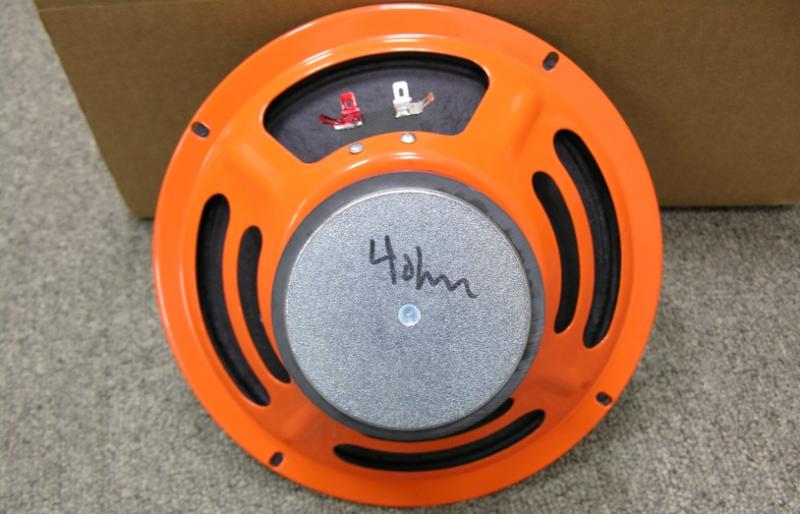Smooth Cone vs Ribbed Cone Speakers
Smooth Cone vs Ribbed Cone Speakers
Smooth or Ribbed, Where Will You Find Pleasure?
Hi-diddly-ho fair neighbors! I’ll just bet that you all have noticed that WGS is now offering the 10" & 12" American speakers with "smooth cones". Here is a pic of a young naked smooooth WGS gal wearing nothing but her pretty lil ohm rating.

Pretty, no? So, anyway, if you have been wondering if a smooth-cone may be the right gal for you and your amp,READ ON!
First, the history: If this were 1949, we would not be having this discussion, because up until about that time all speaker cones were smooth. Why the change? Electric instruments! Those darn new-fangled electric guitars and basses being put out by folks like Leo Fender were really a game-changer. Unlike the console and table-top radios of the day, folks were seriously cranking up their new guitar amps, and in so doing they were seriously challenging the existing speaker technology. Then, as today, players were beginning to revel in the sonic bliss of a fender tube amp with every one of its chicken-head knobs turned to their farthest position. The result was both loud ... and ... get this, rich in harmonic distortion. That last little gem kinda took the speaker engineers by surprise. Who woulda thought that folks would purposely drive their audio equipment to the point of overload distortion?
So a scramble of sorts began. All through the 1950’s, speaker designers were working on new designs that could stand up to the beating the Fenders were dishing out. This was truly the golden era of musical instrument speaker design, and it was during this period that many of the design elements that we now take for granted came to be. For instance:
- Better, higher power voice coil designs
- More robust spiders
- More consistant voice coil gaps
- More durable, robust cone designs
It’s that last feature that we are discussing right now! Innovations included:
- The "accordion" cone surround
- Treated (doped, gooped) cone surround edges
- Thicker and/or stiffer cones
- Ribbed cones
Today, musical instrument speakers generally utilize a mix of several or even all of these features, but we’re talking specifically about ribbed cones, right? Okay, so let’s get back to it!
It turned out that putting ribs on the speaker cones did an excellent job of keeping the cones from warping and "farting out" at higher SPLs, and, generally speaking, didn’t as adversely affect the tone as simply going to a thicker, stiffer material. The end result: within no time virtually all guitar and bass speakers sported those fancy new ribbed cones. That continues to be the case right up until today; but that is beginning to change. So, why the renaissance? Personally, I think it’s a bit like the renaissance of tube amps themselves. Every once in a while someone gets ahold of an old tube amp from the 40’s or early 50’s that has a smooth cone speaker in it and they are mesmerized by the smoky, woody, organic tones it produces; shoot, even that cone breakup that folks fought so hard to stamp out in the 1950’s can be very desirable in the right musical setting. Deja-vu all over again ... imagine, folks actually preferring the sound of a cone distorting!
Okay, now it’s down to the brass tacks! If you are trying to decide between a ribbed or smooth cone WGS American speaker, I’ll try to break down the differences here:
Assuming all things to be equal, the smooth cone speaker will break-up earlier.
The smoothie will sound more vintage, woodsy, smoky ... organic. Think old Chicago blues from the 1940’s, that’s the sound of an old American smooth-cone!
The ribbed-cone speaker will sound a little brighter, will have more clean headroom, and will have a cleaner, more defined sound.
There you have it. Balls in your court; make a good, informed decision! Oh, but then there are the JBL D120F/130F speakers. These critters used an entirely different rule-book, and took a very different path! How, different? Well, let’s put it this way, they retained their smooth cones and AlNiCo magnets all the way up to the end of their production around 1980. These gals are so unique that I think they deserve a blog of there own ... next week! Till then, y’all be good :)
- VAUGHN SKOW's blog
- Log in or register to post comments


Here is my personal opinion on the reversion back to smooth cones: I believe that modern construction techniques, glues, cone papers, doping chemicals and voice coil materials have allowed us to produce smooth cone speakers which impart far more restraint and control in the "wrong" places, while still producing that tone we love in the "right" places. The problem with smooth cones was always in the durability under pressure. Now that we have overcome that hurdle, smooth cone speakers have not only found a home in their period-correct amps, but are now finding homes in more "modern" amp designs, lending a unique tonal palette which was hereto unavailable from a guitar speaker. From a purely tone-shaping standpoint, they are as equally justifiable in a woody as they are in a digital modeling amp.
SORRY VAUGHN....please disregard my response I just sent regarding the smooth cone speakers. I realized, after reading your blog post again, that the main thrust was concerning the ribbed cone. You weren't intending to address the advances in other areas of speaker construction, so, by virtue of that, my reply really has no basis or relevance. Again, sorry. feel free to redact the reply.
Disregard ... no way ... I totally appreciate & agree with ya 100% :-)